LG MS-1245QRS Owner’s Manual
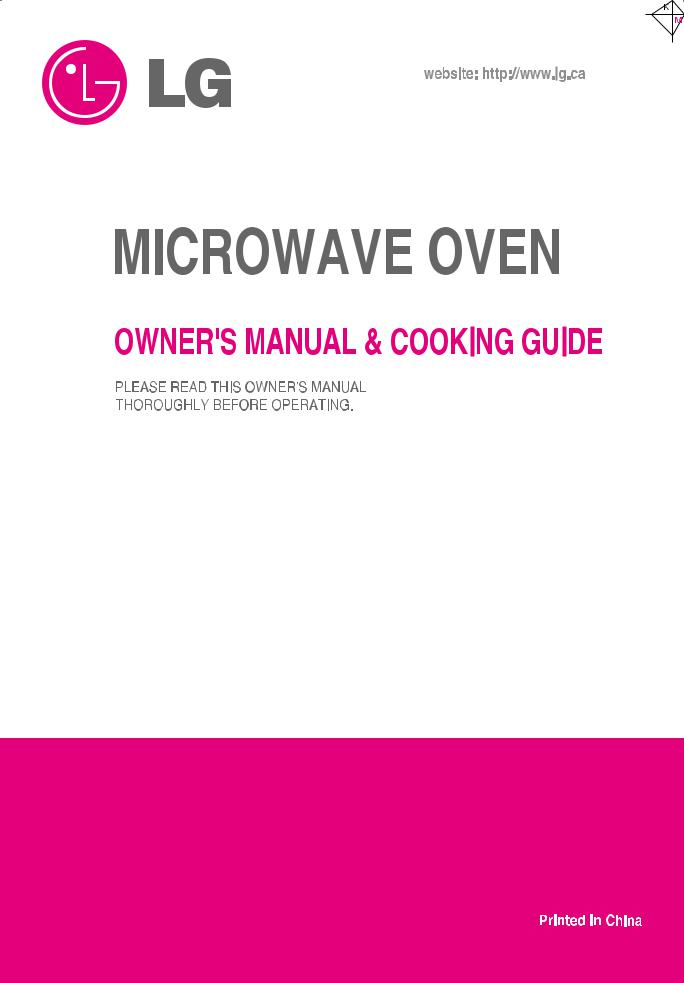
LMS1251SW/SB


 3828W5A8282
3828W5A8282
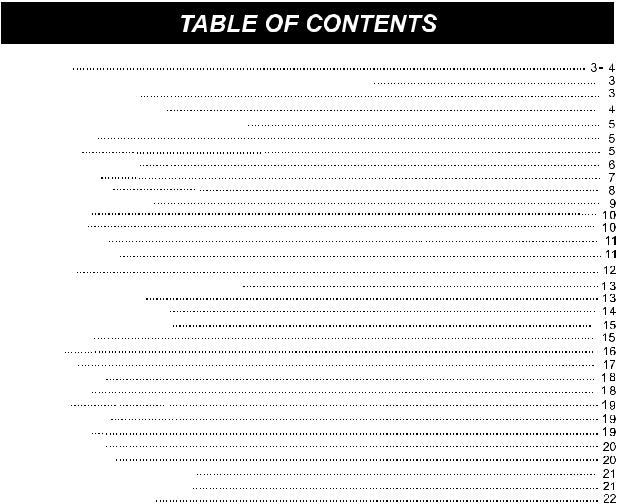
safety |
|
Precaution to Avoid Possible Exposure To Excessive Microwave Energy |
|
Grounding Instructions |
|
Important Safety Instructions |
|
Understanding Your Microwave Oven |
|
Specifications |
|
Installation |
|
Parts and accessories |
|
Control panel |
|
Cookware guide |
|
Tip for microwave cooking |
|
Precautions |
|
Cleaning |
|
Setting Clock |
|
Child Lock-Out |
|
Utensils |
|
Sensor Touch Operation Instruction |
|
Sensor Touch Cook |
|
Sensor Touch Popcorn |
|
Microwaving Made Easy |
|
Auto Cook |
|
Melt |
|
Soften |
|
Auto Defrost |
|
EZ Defrost |
|
Ez ON |
|
Kitchen timer |
|
More/Less |
|
Custom Set |
|
Time Cooking |
|
Using Multi-Power Levels |
|
Multi-Power Setting Guide |
|
Multi-Stage Cooking |
|
Cooking tips ....................................................................................................................................... |
23-24 |
Heating or reheating guide ........................................................................................................................ |
25 |
Fresh vegetable table .............................................................................................................................. |
26 |
Troubleshooting ................................................................................................................................. |
27-29 |
Warranty ............................................................................................................................................................ |
30 |
2

SAFETY
PRECAUTIONS TO AVOID POSSIBLE EXPOSURE TO EXCESSIVE MICROWAVE ENERGY
•Do not attempt to operate this oven with the door open, since open-door operation can result in harmful exposure to microwave energy. It is important not to defeat or tamper with the safety interlocks.
•Do not place any object between the oven front face and the door, or allow soil or cleaner residue to accumulate on sealing surfaces.
•Do not operate the oven if it is damaged.
It is particularly important that the oven door closes properly and that there is no damage to the:
-door (bent),
-hinges and latches (broken or loosened),
-door seals and sealing surfaces.
•The oven should not be adjusted or repaired by anyone except properly qualified service personnel.
GROUNDING INSTRUCTIONS
This appliance must be grounded. In the event of an electrical short circuit, grounding reduces the risk of electric shock by providing an escape wire for the electric current. This appliance is equipped with a cord having a grounding wire and a grounding plug. The plug must be plugged into an outlet that is properly installed and grounded.
proper ground
exists before use
 WARNING
WARNING 
Improper grounding can result in a risk of electric shock. Consult a qualified electrician if the grounding instructions are not completely understood, or if doubt exists as to whether the appliance is properly grounded, and either:
1. If it is necessary to use an extension cord, use only a 3-wire extension cord that has a 3-blade grounding plug, and a 3-slot receptacle that will accept the plug on the appliance.
The marked rating of the extension cord shall
be equal to or greater than the electrical rating of the appliance, or. . . .
2.Do not use an extension cord. If the power supply cord is too short, have a qualified electrician or serviceman install an outlet near the appliance.
NOTES:
1.A short power-supply cord is provided to reduce the risks resulting from becoming entangled in or tripping over a longer cord.
2.Longer cord sets or extension cords are available and may be used if care is exercised in their use.
3.If a long cord or extension cord is used, (1) the marked electrical rating of the cord set or extension cord should be at least as great as the electrical rating of the appliance, (2) the extension cord must be a grounding-type 3-wire cord, and (3) the longer cord should be arranged so that it will not drape over the countertop or tabletop where it can be pulled on by children or tripped over accidentally.
3

SAFETY
IMPORTANT SAFETY INSTRUCTIONS
The safety instructions below will tell you how to use your oven to avoid harm to yourself or damage to your oven.
WARNING - To reduce the risk of burns, electric shock, fire, injury to persons, or exposure to excessive microwave energy:
1.Read all instructions before using the appliance.
2.Read and follow the specific PRECAUTIONS TO AVOID POSSIBLE EXPOSURE TO EXCESSIVE
MICROWAVE ENERGY found on page 3 of this manual.
3. This appliance must be grounded. Connect only to properly grounded outlet. See GROUNDING INSTRUCTIONS found on page 3 of this manual .
4. Install or locate this appliance only in accordance with the provided installation instructions.
5. Some products, such as whole eggs and sealed containers – for example, closed glass jars are able to explode and should not be heated in this oven.
6.Use this appliance only for its intended use as described in the manual. Do not use corrosive chemicals or vapors in this appliance. This type of oven is specifically designed to heat, cook, or dry food. It is not designed for industrial or laboratory use.
7.As with any appliance, close supervision is necessary when used by children.
8.Do not operate this appliance if it has a damaged cord or plug, if it is not working properly, or if it has been damaged or dropped.
9. This appliance should be serviced only by qualified service personnel. Contact the nearest authorized service facility for examination, repair, or adjustment.
10. Do not cover or block any openings on the appliance.
11. Do not store this appliance outdoors. Do not use this product near water – for example, near a kitchen sink, in a wet basement, near a swimming pool, or similar location.
12. Do not immerse cord or plug in water. 13. Keep cord away from heated surfaces.
14. Do not let cord hang over the edge of a table or counter.
15. When cleaning surfaces of door and oven that come together on closing the door, use only mild, nonabrasive soaps or detergents applied with a sponge or soft cloth.
16. To reduce the risk of fire in the oven cavity:
a.Do not overcook food. Carefully attend appliance when paper, plastic, or other combustible materials are placed inside the oven to facilitate cooking.
b.Remove wire twist-ties from paper or plastic bags before placing bag in oven.
c.If materials inside the oven ignite, KEEP OVEN DOOR CLOSED, turn oven off, and disconnect the power cord or shut off power at the fuse or circuit breaker panel.
d.Do not use the cavity for storage purposes. Do not leave paper products, cooking utensils, or food in the cavity when not in use.
17.Liquids such as water, coffee, or tea are able to be overheated beyond the boiling point without appearing to be boiling. Visible bubbling or boiling when the container is removed from the microwave oven is not always present. THIS COULD RESULT IN VERY HOT LIQUIDS SUDDENLY BOILING OVER WHEN THE CONTAINER IS DISTURBED OR A SPOON OR OTHER UTENSIL IS INSERTED INTO THE LIQUID. To reduce the risk of injury to persons; 1) Do not overheat the liquid. 2) Stir the liquid both before and halfway through heating it. 3) Do not use straight-sided containers with narrow necks. 4) After heating, allow the container to stand in the microwave oven for a short time before removing the container. 5) Use extreme care when inserting a spoon or other utensil into the container.
18.Avoid heating small-necked containers such as syrup bottles.
19.Avoid using corrosive and vapors, such as sulfide and chloride.
20.Liquids heated in certain shaped containers (especially cylindrical-shaped containers) may become overheated. The liquid may splash out with a loud noise during or after heating or when adding ingredients (instant coffee, etc.), resulting in harm to the oven and possible injury. In all containers, for best results, stir the liquid several times before heating. Always stir liquid several times between reheatings.
SAVE THESE INSTRUCTIONS
4
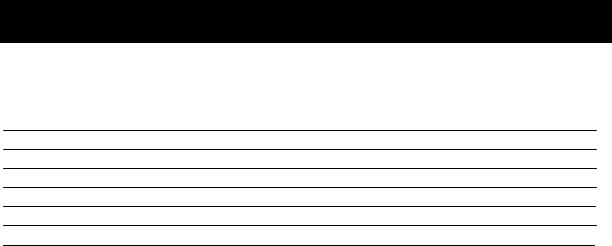
UNDERSTANDING YOUR MICROWAVE OVEN
SPECIFICATIONS
MODEL |
|
|
LMS1251SW/SB |
||||
|
|
|
|
|
|
|
|
Power Supply |
|
|
|
120 V AC, 60 Hz |
|||
Rated Power Consumption |
|
|
1500 W |
|
|||
Microwave Output |
|
|
|
|
*1100 W |
|
|
Frequency |
|
|
|
|
2450 MHz |
|
|
Rated Current |
|
|
|
|
13.5 A |
|
|
Overall Dimensions (W |
x |
x |
|
21 |
/8 '' x 12 /2 '' x 17 /8'' |
||
|
H D) |
||||||
|
|
|
|
7 |
1 |
1 |
|
Oven Cavity Dimensions (W |
x x |
14 |
/16'' |
x 9 /8'' x 15 /8'' |
|||
H D) |
|||||||
|
|
|
|
11 |
5 |
5 |
|
Capacity of Oven Cavity |
|
|
1.2 Cu.ft. |
|
|||
*IEC 60705 RATING STANDARD
Specifications subject to change without prior notice.
INSTALLATION
A. Circuits
For safety purposes this oven must be plugged into a 15 or 20 Amp circuit. No other electrical appliances or lighting circuits should be on this line. If in doubt, consult a licensed electrician.
B. Voltage Warning
The voltage used at the wall receptacle must be the same as specified on the oven name plate located on the back or on the side of the control panel of the oven. Use of a higher voltage is dangerous and may result in a fire or other type of accident causing oven damage. Low voltage will cause slow cooking. In case your microwave oven does not perform normally in spite of proper voltage, remove and reinsert the plug.
C. Placement of the Oven
Your microwave oven can be placed easily in your kitchen, family room, or anywhere else in your home. Place the oven on a flat surface such as a kitchen countertop or a specially designed microwave oven cart. Do not place oven above a gas or electric range. Free air flow around the oven is important. Allow at least 4 inches of space at the top, sides, and back of the oven for proper ventilation.
D. Do not block the air vents
All air vents should be kept clear during cooking. If air vents are covered during oven operation the oven may overheat. In this case, a sensitive thermal safety device automatically turns the oven off. The oven will be inoperable until it has cooled sufficiently.
E. Radio interference
1.Microwave oven operation may interfere with TV or radio reception.
2.When there is interference, it may be reduced or eliminated by taking the following measures:
a.Clean the door and the sealing surfaces of the oven.
b.Reorient the receiving antenna of radio or television.
c.Relocate the microwave oven in relation to the TV or radio.
d.Move the microwave oven away from the receiver.
e.Plug the microwave oven into a different outlet so that microwave oven and receiver are on different branch circuits.
5
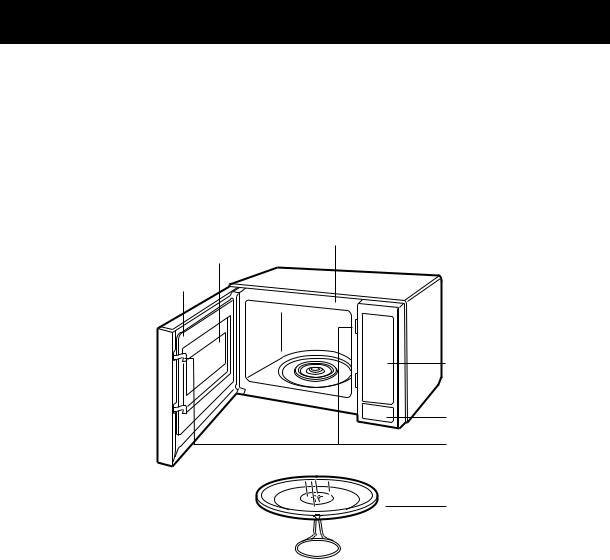
UNDERSTANDING YOUR MICROWAVE OVEN
PARTS AND ACCESSORIES
Your oven comes with the following accessories: 1 Use and Care Manual
1 Glass Turntable
1 Rotating Ring
Oven Front Plate
Window Door Screen
Door Seal
 Display Window
Display Window
Control Panel
Door Open Button
Safety Door Lock System
Turntable


 Rotating ring
Rotating ring
NOTE:This microwave oven is designed for household use only. It is not recommended for commercial use.
6
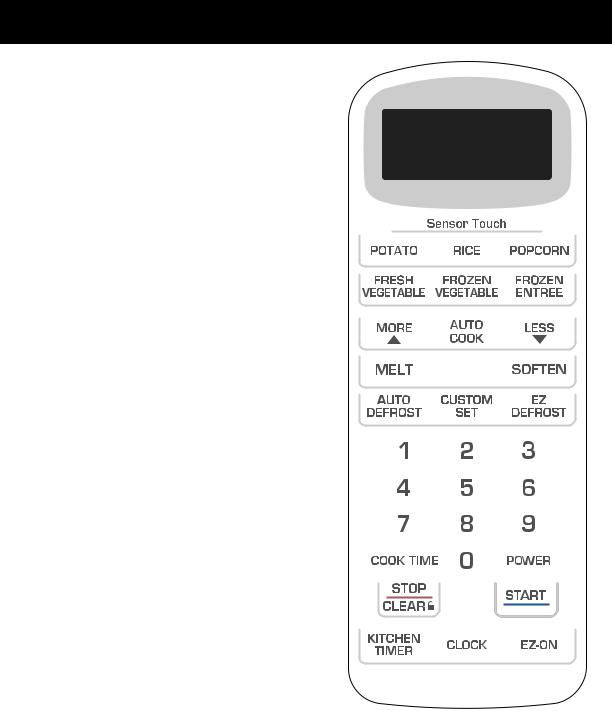
UNDERSTANDING YOUR MICROWAVE OVEN
CONTROL PANEL
1.DISPLAY. The display includes a clock and indicators that tell you time of day, cooking time settings, and cooking functions selected.
2.SENSOR TOUCH Touch this pad to cook without entering a cook power or time.
3.MELT. Touch number pads to melt choclate, cheese,butter, or mashmallows.
4.SOFTEN. Touch this pad to softeen ice cream, cream cheese, butter,or frozen juice.
5. Ez DEFROST. Touch this pad to thaw only 1lb of food very quickly.
6.AUTO COOK. Touch this pad to select programming food items.
7.AUTO DEFROST. Touch this pad to thaw ground meat, poultry, or steaks/chops by entering a weight.
8.NUMBER PADS. Touch number pads to enter cooking time, power level, quantities, or weights.
9 COOK TIME. Touch this pad to set a cooking time. 10. POWER. Touch this pad to set a cooking power.
11. MORE. Each time you touch this pad, you add 10 seconds to the cooking time.
12.LESS. Each time you touch this pad, you subtract 10 seconds from the cooking time.
13. CLOCK. Touch this pad to enter the time of day.
14. KITCHEN TIMER. Touch this pad to use your microwave oven as a kitchen timer.
15.CUSTOM SET. Touch this pad to select sound(on/off), clock(on/off), scroll speed(slow, normal, fast) and unit(lbs./kg.).
16. EZ ON. Touch this pad to cook at 100% cook power for 30 seconds up to 3 minutes; after 3 min-
utes, every touch will add 1 minute up to 99 min 59 seconds.
17. START. Touch this pad to start all entries (except the ONE TOUCH and EZ ON functions, which start automatically).
18. STOP/CLEAR. Touch this pad to stop the oven or clear entries and to turn Child Lock on or off.
7

UNDERSTANDING YOUR MICROWAVE OVEN
COOKWARE GUIDE
Most heat-resistant, non-metallic cookware is safe for use in your microwave oven. However, to test cookware before using, follow these steps:
1.Place the empty cookware in the microwave oven.
2.Measure 1 cup of water in a glass measuring cup and place it in the oven beside the cookware.
3.Microwave on 100% power for 1 minute. If the dish is warm, it should not be used for microwave cooking.
USE |
DO NOT USE |
|
Ovenproof Glass |
Metal Utensil |
|
• Glass treated for use in high-intensity heat |
• Metal shields food from microwave energy and |
|
includes utility dishes, bread dishes, pie plates, |
produces uneven cooking. Avoid metal skewers, |
|
cake plates, liquid measuring cups, casseroles, |
thermometers, or foil trays. |
|
and bowls without metallic trim. |
• Metal utensils can cause arcing, which is a |
|
China |
discharge of electric current. Arcing can damage |
|
your microwave oven. |
||
• Bowls, cups, serving plates, and platters without |
|
|
metallic trim can be used in your oven. |
Metal Decoration |
|
Plastic |
• Do not use metal-trimmed or metal-banded |
|
dinnerware, casserole dishes, etc. |
||
• When using plastic wrap as a cover, make sure |
|
|
that the dish is deep enough so the plastic wrap |
Centura™ Tableware |
|
does not touch the food. As the food heats, it may |
• The Corning Company recommends that you |
|
melt the plastic wrap wherever the wrap touches |
do not use Centura tableware and some |
|
the food. |
Corelle™ closed-handle cups for microwave |
|
• Place plastic wrap loosely over the top of the dish |
cooking. |
|
and secure it by pressing the wrap to the sides of |
Aluminum Foil |
|
the dish. |
||
• Vent by turning back one corner of the plastic wrap. |
• Avoid large sheets of aluminum foil because |
|
This will allow excess steam to escape. |
they hinder cooking and may cause arcing. |
|
• Use small pieces of foil to shield poultry legs |
||
• Use plastic dishes, cups, semi-rigid freezer |
||
containers, and plastic bags only for short time |
and wings. |
|
cooking. Use these with care because the |
• Keep all aluminum foil at least 1 inch from the |
|
plastic may soften from the heat of the food. |
walls and door of the oven. |
|
Paper |
Wood |
|
• Microwave-safe paper towels, waxed paper, paper |
• Wooden bowls, boards, and baskets will dry out |
|
napkins, and paper plates with no metallic trim or |
and may split or crack when you use them in the |
|
design can be used in your oven. |
microwave oven. |
|
• Refer to the manufacturer’s label for use of any |
Tightly Closed Containers |
|
paper product in the microwave oven. |
||
|
• Tightly closed cookware can explode. Be sure |
|
|
to leave an opening for steam to escape from |
|
|
covered cookware. |
|
|
Brown Paper |
|
|
• Avoid using brown paper bags. They absorb |
|
|
heat and could burn. |
|
|
Metal Twist Ties |
|
|
• Always remove metal twist ties as they can |
|
|
become hot and cause a fire. |
|
|
|
8

UNDERSTANDING YOUR MICROWAVE OVEN
TIPS FOR MICROWAVE COOKING
BROWNING
Meat and poultry with high fat content that are cooked for 10 or 15 minutes or longer will brown lightly. Foods cooked a shorter time can be brushed with a browning agent, such as Worcestershire sauce, soy sauce, or barbecue sauce.
COVERING
A cover traps heat and steam and causes the food to cook more quickly. Use a lid or microwave-safe plastic wrap with one corner folded back to vent the excess steam. Lids on glass casseroles can become hot during cooking. Handle carefully. Waxed paper will prevent the food from splattering in the oven and help retain heat. When warming bread items, use waxed paper, napkins, or paper towels. To absorb extra moisture, wrap sandwiches and fatty foods in paper towels.
SPACING
Arrange individual foods, such as baked potatoes, cupcakes, and hors d’oeuvres in a circle and at least 1 inch apart. This will help the food cook more evenly.
STIRRING
Stirring blends flavors and redistributes the heat in foods. Always stir from the outside toward the center of the dish. Food at the outside of the dish heats first.
TURNING
Large foods, such as roasts and whole poultry, should be turned so that the top and bottom cook evenly. Also turn over chicken pieces and chops.
ARRANGEMENT
Do not stack food. Arrange in a single layer in the dish for more even cooking. Because dense foods cook more slowly, place thicker portions of meat, poultry, fish, and vegetables toward the outside of the dish.
TESTING FOR DONENESS
Because foods cook quickly in a microwave oven, you need to test frequently for doneness.
STANDING TIME
Food often needs to stand from 2 to 15 minutes after you remove it from the oven. Usually, you need to cover food during standing time to retain heat. Remove most foods when they are slightly undercooked and they will finish cooking during standing time. The internal temperature of food will rise about 10 °F during standing time.
SHIELDING
To prevent some portions of rectangular or square dishes from overcooking, you may need to shield them with small strips of aluminum foil to block the microwaves. You can also cover poultry legs and wing tips with foil to keep them from overcooking.
Always keep foil at least 1 inch from oven walls to prevent arcing.
PIERCING
Pierce the shell, skin, or membrane of foods before cooking to prevent them from bursting. Foods that require piercing include yolks and whites of eggs, hot dogs, clams, oysters, and whole vegetables, such as potatoes and squash.
9
